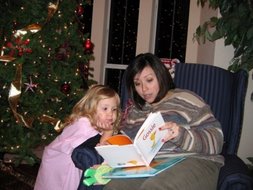Janeczko, Paul B., selector. Chris Raschka, illus. 2001. A poke in the i: a collection of concrete poems. Cambridge, MA: Candlewick Press.
In the "Notes from the Editor" to A Poke in the I: a Collection of Concrete Poems, Paul Janeczko writes, "Concrete poems are different from regular poems; in fact, they're a lot more playful...." This compilation of thirty poems is exactly that. Each poem is stylized, abstract and dramatic. Clever phrasing, spelling, font and shape all make these poems more interesting. Poetry is meant to be heard, but in this case, it is also meant to be seen. The verse is already visual then paired with illustrations by Chris Raschka, the works bound off the page appealingly.
The text on every page of this collection is distinctive. Each poem features a different size, style and shape of font that reflects the theme or subject of the poem. A perfect example of this is the opening verse "A Seeing Poem" by Robert Fronman. In it he is describing how poetry often works as a "light in someone's mind." This concept is further supported by the words themselves, which are manipulated to depict a light bulb. The font begins at one size, then flips around, gets bigger and at one point becomes large and segmented. The shapes cleverly play off the meaning of the words and the imagery they present. This roundabout relationship helps make this a dynamic attractive collection.
Because this style is so "playful," the poems themselves are often quite humorous. In "Tennis Anyone" by Monica Kulling, each line is placed on opposite sides of each page, forcing the reader to bounce back and forth in order to read it. This mimics the movements of spectators at a tennis match watching the ball, "Tennis/is a/game I/could watch/for hours/but my/neck won't/let me" (31). Not only does the reader then physically see the message of the poem, but in this particular case it can also be felt quite literally by the movement itself.
In some works, the wordplay is found in the verse and the title, such as Reinhard Dohl's poem "Pattern Poem with an Elusive Intruder." This poem features the word "Apfel" repeated over and over in the shape of an apple, while tucked away on the side is the word "Wurm." The imagery represented here is instant and familiar skillfully recreated with language. Aram Saroyan manipulates spelling and letter placement creating irresistible onomatopoeia. The poem begins with the title word, "Crickets," but then is manipulated by removing a letter, then adding it back. It is a way to play with the visual and the audible senses at the same time.
The artwork in this book is vivid, bright and energetic. Raschka uses bold colors and abstract design. He combines broad strokes with patterned pieces of fabric or paper taking a multi-media approach. Nothing is muted, contrived or conventional in these pictures. Skin colors range from blue to bright yellow to deep black. Patterns dominate each page filling them with detail, yet plenty of white space is left so as not to overwhelm. This only helps add to the liveliness of the works, supporting their upbeat nature.
Overall this collection is entertaining, highly enjoyable and vibrant. Because of the sophisticated play on words and the relationship to the shape of the poems, this collection may be more appropriate for older children. Janeczko carefully selects only poems that work on various levels appealing to the visual, audible and at times physical senses. The heightened awareness of the visual lends humor to the works along with the wording of the poems themselves. Raschka's abstract artwork only adds to the collection making it all the more appealing. Because theses poems work on so many levels, it is an ideal book to read over and over again.
